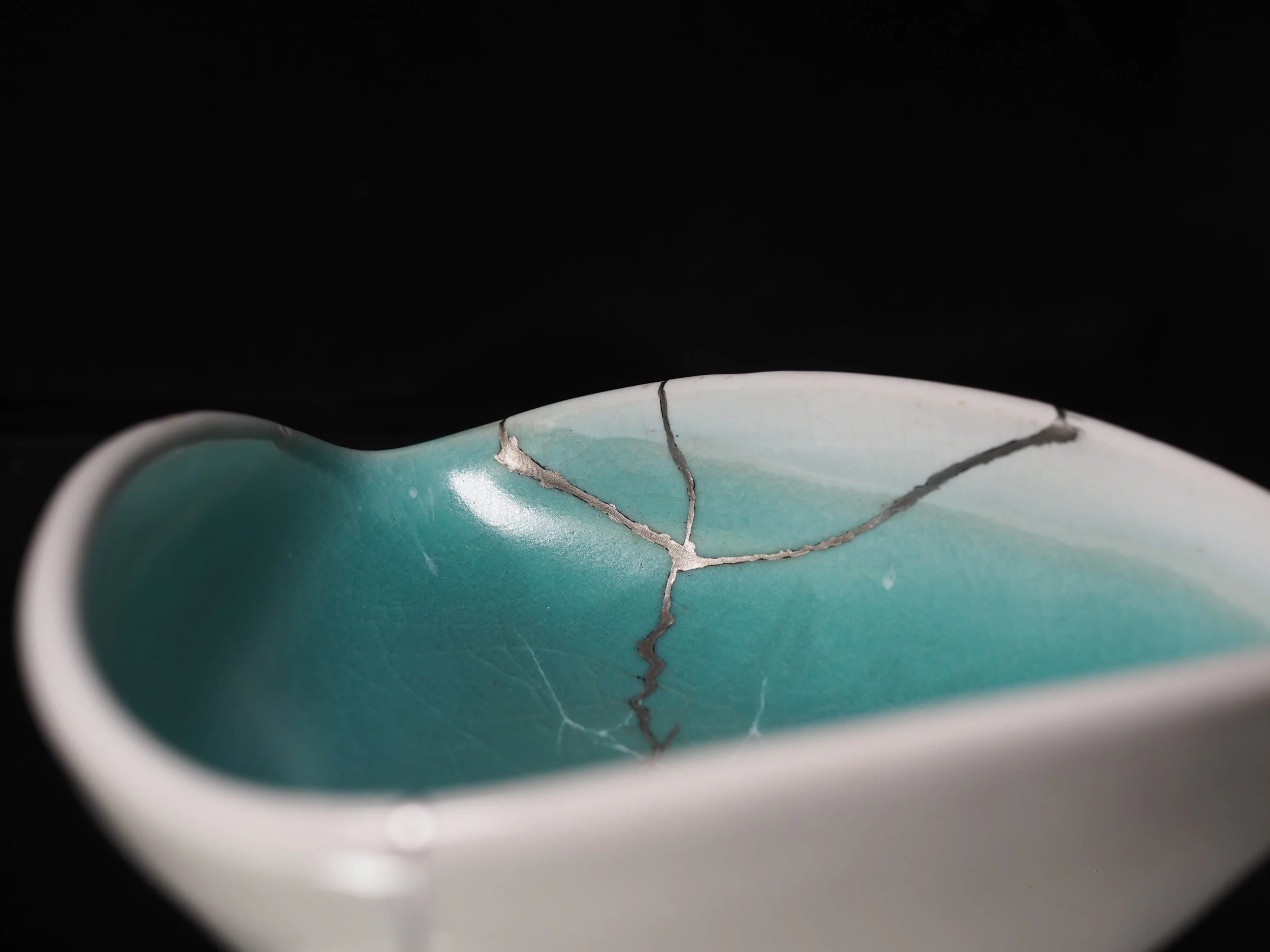Kintsugi Jewelry: Carrying the Story with You
If you have made it to this page you’ve seen kintsugi before, shards of pottery joined with seams of gold. It’s delicate, symbolic, and beautiful. But most Kintsugi jewelry floating around online? It’s either a distant nod to the philosophy, or perfectly fine ceramics broken, glued together with “gold,” and thrown on a cord.
That’s not what I do.
When I first started practicing kintsugi I wanted to make a jewelry line, but it took 7 years to actually get there. My skills were never in the right place, because I knew I wanted this to be something special, and honestly something good, well made, and beautiful. The name, The Remnants Collection, was the first seed that has finally started to sprout!
My jewelry is rooted in actual Kintsugi repair. Every piece begins with a real ceramic fragments specifically discarded by the artist, broken on purpose because they couldn’t be sold or used. They are made wearable slowly, through technical process and genuine collaboration.
Not Just a Nod to Kintsugi: The Real Thing
Each pendant is made using a modified non-traditional Kintsugi technique I developed in my studio. I use real 23.75k gold leaf with a touch of platinum for durability, and the bezels are individually handmade in fine silver. I don’t grind pieces into tidy shapes to fit mass-market settings, instead, I craft a custom bezel that follows the break’s natural contours.
The chains are gold vermeil and mass-produced for affordability, and the bails (that small loop connecting the pendant to the chain) are my own design, cast in sterling silver in small batches.
This work sits in that rare space between jewelry and story-telling—a physical object carrying visible transformation.
Collaboration at the Core
The fragments I use come directly from ceramicists I admire and work closely with. I don’t purchase these scraps—they’re waste that would otherwise be thrown away—but every piece is documented, tracked, and honored. I keep individual drawers for each potter, and each pendant includes their name on the hang tag. That way, if someone loves a particular glaze or texture, they know exactly who to turn to.
This project is grounded in lineage—of both craft and community.
Meet the Makers
Charlotte Collier-Hunter of Preaface Ceramics is a London-based disabled artist whose practice is steeped in the symbolic, the alchemical, and the elemental. A former nurse, her journey into clay is one of radical reinvention. She creates both functional and sculptural work for clients across the globe. Her trust in me has been incredibly humbling, on meeting she entrusted me with repairing the first bowl she ever fired! Such an incredible and loud supporter of my work and that goes both ways.
Flora Fabris of Ooak Creation is a French-born studio potter living in London, blending quiet architectural forms with raw, ash-glazed textures. A former civil engineer, her work is balanced between precision and surrender. She was the first artist to offer me scraps and continues to trust me with both repair commissions and shared creative projects. One of our collaborations—a repair she plans to showcase at an event—was generously designed to help support my travel for further Kintsugi study in Japan.
Lilly Maetzig of Mae Ceramics is based in southeast London. Her functional ceramics focus on stillness, minimalism, and everyday joy. She’s also an educator and author, sharing her love for pottery in books and video courses. Her pieces are used in restaurants, design stores, and homes worldwide. Her social media presence is phenomenal and I am still shocked she responded to my comment on her TikTok seeing if she wanted to participate in this project.
Why This Line Exists
Kintsugi jewelry lets the philosophy travel. It’s a way to honor the cracks and scars we carry—not as symbols of struggle, but as traces of where we have shown ourselves empathy and compassion. Holding the reminder close to our hearts that we all deserve care and reflect the journey we each take, we are seen, respected, and cherished.
What I found missing in Kintsugi jewelry was a blend of authenticity and refinement. Some pieces use faux gold, cheap glues, or are made purely as a trend. Others are closer to fine jewelry but lack any grounding in actual ceramic repair. This work is my answer: a practice that honors the material and the maker, with a finish that holds up to both scrutiny and sentiment.
Every pendant is one-of-a-kind.
The Lineage Is the Point
Each piece is made with purpose—and with provenance. The origin of every ceramic shard is recorded, respected, and shared. It’s not just about what’s broken and made whole. It’s about whose hands helped shape that story, from clay to kiln to gold.
If you’re a potter interested in contributing to the project, I’d love to hear from you. And if you’re looking for something to carry forward—quietly meaningful, gorgeously made—these pendants were designed for just that.


